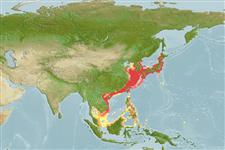Common names from other countries
Environment: milieu / climate zone / depth range / distribution range
বাস্তুসংস্থান
সামুদ্রিক তলদেশ বিহারী; মহাসাগরে বিচরনক্ষম (Ref. 51243); গভীরতার পরিসীমা 10 - 200 m (Ref. 11230). Subtropical; 62°N - 1°N, 99°E - 163°E (Ref. 54698)
Western Pacific: Japan, Sakhalin, Kuril Islands, Korean Peninsula to the South China Sea.
Length at first maturity / আকৃতি / ওজন / Age
Maturity: Lm ?, range 40 - ? cm
Max length : 103 cm TL পুরুষ/ লিঙ্গ অনিধর্ারিত ; (Ref. 40637); সবের্াচ্চ প্রকাশিত ওজন : 9.1 kg (Ref. 40637)
পৃষ্ঠীয় কাঁটা (মোট ) : 0; পৃষ্ঠীয় নরম পাখনা দন্ড (মোট ) : 77 - 81; পায়ূ কাঁটা : 0; পায়ূর নরম পাখনা্তুন্ড: 59 - 61; কশেরুকা : 38.
Most highly prized of the Japanese flounders.
Distinct pairing (Ref. 205).
Masuda, H., K. Amaoka, C. Araga, T. Uyeno and T. Yoshino, 1984. The fishes of the Japanese Archipelago. Vol. 1. Tokai University Press, Tokyo, Japan. 437 p. (text). (Ref. 559)
IUCN Red List Status (Ref. 130435)
CITES (Ref. 128078)
Not Evaluated
Threat to humans
Harmless
Human uses
মৎস্য: অত্যন্ত বাণিজ্যিক ; এ্যাকুয়াকালচার (জলজ পালন) : বাণিজ্যিক
হাতিয়ার
Special reports
Download XML
ইন্টারনেট সুত্র
Estimates based on models
Preferred temperature (Ref.
115969): 8.6 - 25, mean 18.8 (based on 241 cells).
Phylogenetic diversity index (Ref.
82804): PD
50 = 0.5000 [Uniqueness, from 0.5 = low to 2.0 = high].
Bayesian length-weight: a=0.00794 (0.00438 - 0.01441), b=3.07 (2.90 - 3.24), in cm Total Length, based on LWR estimates for this species & (Sub)family-body (Ref.
93245).
ট্রফিক পর্যায়ে (Ref.
69278): 4.5 ±0.8 se; based on diet studies.
স্থিতিস্থাপক (Ref.
120179): মাধ্যম , সর্বনিম্ন প্রজন দ্বিগুনের সময় ১.৪-৪.৪ বৎসর (tm=3; Fec= 3 million).
Fishing Vulnerability (Ref.
59153): High vulnerability (60 of 100).
Climate Vulnerability (Ref.
125649): Moderate vulnerability (43 of 100).
